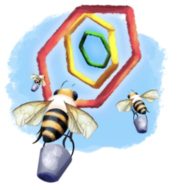Team and Role Balancing
Teams require some coordination, especially in exploring new forms where careful observation and iteration is so central to our approach. When the form is new, the art of balancing across disciplines and goals becomes much harder and more important.
- Draw on established lessons. We think of “good teams” for this project in two ways: for game design (to balance engagement) as well as community-based participatory design (to balance power). There are great readings and best practices for each. (We may expand on this soon in another post.)
Possible roles. Our main advice: avoid assuming that one person will do multiple roles without asking them. For example, many historians do not want to be makers, but still could have an invaluable role on a team – just give them the right role, and find a counterpart.
- Storytellers and game designers: Able to translate the content (e.g., see historian below) into characters, roles, and dramatic tension – like a good script, poem, or challenge. Interactive stories often draw on game design when they go beyond a “next” button to make choices feel meaningful, to celebrate the feedback we give players on their choices, to balance the right level of uncertainty and challenge, etc.
- Historians and fact checkers: These need to be the most familiar with the background content of the activity. Should be able to offer content suggestions or narrative chains if your activity contains multiple locations or topics. You might also use these folks for gathering new stories, or even community asset mapping.
- Makers and multimedia artists: They will actually build the content in Hive Mechanic, and make any graphics, posters, audio files, and videos. This person should have a can-do attitude toward technology, and feel comfortable organizing files on shared drives.
- Public space and attention partners: people and organizations with storefront windows, front desks, event staff, radio stations, managers for popular social media groups, etc. Essential for distribution and attention.
- Stakeholder partners: essential for trust, getting the right content, etc.
Tips for building the team
- Start with makers or historians. You can start by finding content experts OR by finding people who like to make things… but if either group is missing, it will be hard.
- Leverage existing connections. You do not have to build a team completely from scratch when using Hive Mechanic. Talk to groups that have done events at your library, see if they would be interested in working on a project using Hive Mechanic, even if it is just one person from that organization doing one specific task on the project team.
- Workshops can be used to catalyze teams. If you want to create a team from scratch, host events or workshops using Hive Mechanic that would bring in community members. They can talk with you and each other about what the community needs or would enjoy and organic teams might present themselves through this interaction.
- Tap into existing outdoor events. What are some outdoor activities in your community that are the most popular? Bringing in community representatives onto the project to help create the game in the context of a popular activity. They can ask the questions and help decide how the desired content can fit into the community. This can be a rotating role as well so the project always has outside eyes on the project
What other ideas do you have? Let us know your thoughts for what we might add here!
